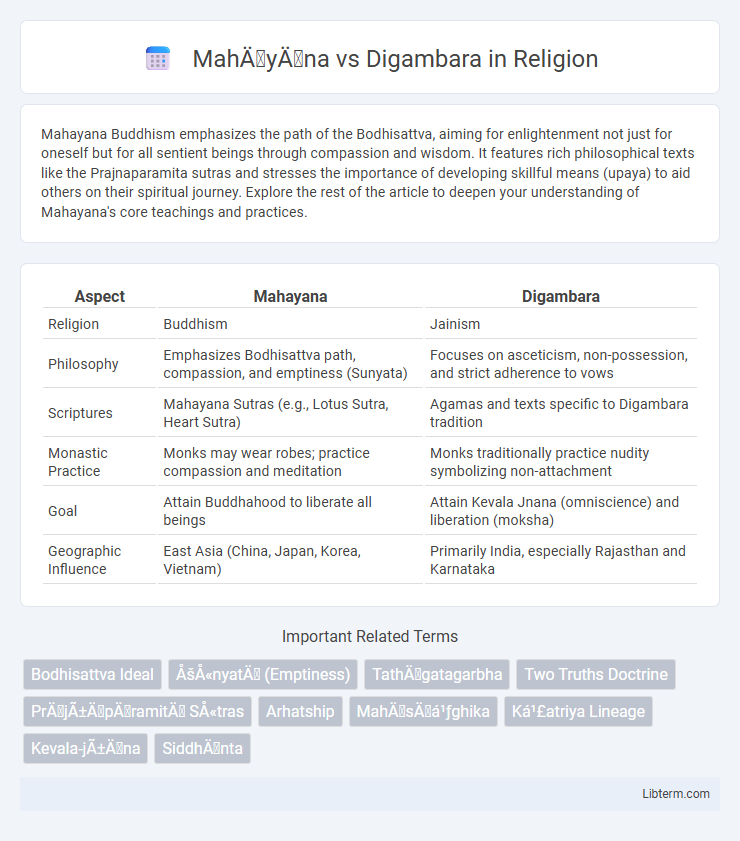Mahayana Buddhism emphasizes the path of the Bodhisattva, aiming for enlightenment not just for oneself but for all sentient beings through compassion and wisdom. It features rich philosophical texts like the Prajnaparamita sutras and stresses the importance of developing skillful means (upaya) to aid others on their spiritual journey. Explore the rest of the article to deepen your understanding of Mahayana's core teachings and practices.
Table of Comparison
| Aspect | Mahayana | Digambara |
|---|---|---|
| Religion | Buddhism | Jainism |
| Philosophy | Emphasizes Bodhisattva path, compassion, and emptiness (Sunyata) | Focuses on asceticism, non-possession, and strict adherence to vows |
| Scriptures | Mahayana Sutras (e.g., Lotus Sutra, Heart Sutra) | Agamas and texts specific to Digambara tradition |
| Monastic Practice | Monks may wear robes; practice compassion and meditation | Monks traditionally practice nudity symbolizing non-attachment |
| Goal | Attain Buddhahood to liberate all beings | Attain Kevala Jnana (omniscience) and liberation (moksha) |
| Geographic Influence | East Asia (China, Japan, Korea, Vietnam) | Primarily India, especially Rajasthan and Karnataka |
Understanding Mahāyāna and Digambara: An Overview
Mahayana and Digambara represent distinct traditions within Indian spirituality, with Mahayana primarily associated with Buddhism and Digambara with Jainism. Mahayana emphasizes the path of the bodhisattva, aspiring to attain enlightenment for the benefit of all beings, while Digambara focuses on asceticism and the liberation of the soul through strict renunciation and adherence to non-violence. Understanding Mahayana involves recognizing its expansive teachings and compassionate ideals, whereas Digambara highlights rigorous monastic discipline and the importance of inner purity.
Historical Origins and Development
Mahayana Buddhism emerged around the 1st century CE, evolving from earlier Buddhist traditions with its emphasis on the bodhisattva ideal and expansive scripture collections like the Mahayana sutras. Digambara Jainism traces its origins to ancient India, formalizing around the early centuries CE with a strict ascetic practice, characterized by monks' nudity symbolizing renunciation and an emphasis on the teachings of Lord Mahavira. Both traditions developed distinct scholastic and ritual practices, reflecting their unique doctrinal priorities and historical contexts within Indian religious history.
Core Philosophical Beliefs
Mahayana emphasizes the Bodhisattva ideal, aiming for enlightenment to aid all sentient beings, while Digambara upholds strict asceticism and the belief that only those who renounce all possessions can achieve liberation. Mahayana incorporates the concept of emptiness (sunyata) and the possibility of multiple buddhas, contrasting with Digambara's adherence to the Jain Tirthankaras and the doctrine of anekantavada (non-absolutism). The divergence in scriptural interpretation and ritual practice reflects these core philosophical distinctions.
Scriptural Traditions and Texts
Mahayana and Digambara traditions differ significantly in their scriptural foundations, with Mahayana emphasizing the Mahayana Sutras, such as the Lotus Sutra and Heart Sutra, which propagate the Bodhisattva path and universal salvation. Digambara Jainism adheres strictly to the Agamas, ancient canonical texts like the Satkhandagama and Uvasagharam, which detail rigorous ethical codes and metaphysical doctrines. These textual differences shape each tradition's distinct theological interpretations and ritual practices, reflecting divergent spiritual priorities and philosophical frameworks.
Practices and Rituals Differentiated
Mahayana and Digambara traditions exhibit distinct practices and rituals shaped by their doctrinal beliefs; Mahayana emphasizes the Bodhisattva path, incorporating rituals such as mantra chanting, meditation, and elaborate temple ceremonies to cultivate compassion and wisdom. Digambara practitioners prioritize strict asceticism, nude renunciation symbolizing non-attachment, and rigorous vows, with rituals focusing on physical austerities and scriptural study to achieve liberation. Temple worship in Mahayana often includes iconography and offerings, whereas Digambara rituals are minimalistic, emphasizing self-discipline and inner purity.
Views on Liberation and Enlightenment
Mahayana emphasizes liberation (moksha) through the Bodhisattva path, advocating universal enlightenment and compassion for all beings before attaining final nirvana. Digambara, a major Jain sect, stresses liberation through strict asceticism, non-attachment, and self-discipline, believing only those who renounce all possessions can achieve kevala jnana (omniscience). While Mahayana promotes accessible enlightenment for all, Digambara insists on rigorous practices and total renunciation as essential for spiritual liberation.
Monastic Rules and Community Structure
Mahayana Buddhism emphasizes a more flexible approach to monastic rules, allowing lay practitioners greater involvement while focusing on the Bodhisattva ideal of compassion and universal salvation. Digambara Jainism enforces strict monastic codes including complete nudity for monks, symbolizing renunciation, and maintains a rigorous hierarchical community structure with clear distinctions between ascetics and laity. Both traditions prioritize disciplined community organization but differ significantly in their interpretation and application of ascetic practices and monastic regulations.
Iconography and Artistic Expressions
Mahayana and Digambara traditions exhibit distinct iconographic and artistic expressions reflecting their doctrinal differences; Mahayana iconography often emphasizes bodhisattvas adorned with elaborate jewelry and serene expressions symbolizing compassion and enlightenment, while Digambara art portrays Tirthankaras in nude form, highlighting renunciation and spiritual purity. Mahayana sculptures and paintings incorporate intricate halos, lotus motifs, and dynamic postures to convey transcendence and divine activity, contrasting with the austere, meditative poses and minimalistic style characteristic of Digambara representations. These visual divergences underscore contrasting theological emphases--Mahayana's accessible compassion versus Digambara's rigorous asceticism--and shape the aesthetic landscape of Jain sacred art.
Influence on Regional and Global Buddhism
Mahayana Buddhism, with its emphasis on the Bodhisattva ideal and expansive scriptures like the Prajnaparamita sutras, profoundly shaped East Asian spiritual practices and art, spreading across China, Korea, Japan, and Vietnam. Digambara, a major Jain sect emphasizing asceticism and the non-possession principle, primarily influenced Jain communities in India, reinforcing strict monastic discipline and doctrinal purity. The Mahayana tradition's global impact is evident in diverse contemporary Buddhist schools, while Digambara's regional presence preserves ancient Jain philosophies and rituals.
Contemporary Relevance and Interactions
Mahayana Buddhism emphasizes compassion and the Bodhisattva path, influencing global Buddhist practices and interfaith dialogues, while Digambara Jainism upholds stringent asceticism and non-possession, impacting ethical debates and lifestyle choices. Contemporary relevance arises as Mahayana teachings address modern social justice and mental health, whereas Digambara principles contribute to discussions on environmental sustainability and non-violence. Interaction between these traditions fosters mutual respect and philosophical exchange, enriching spiritual diversity and promoting peace in multicultural societies.
Mahāyāna Infographic

 libterm.com
libterm.com